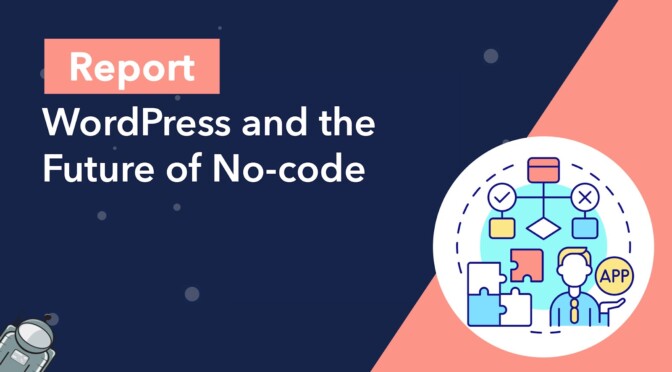Did you know that by 2025, up to 70% of new applications developed by organizations will use no-code or low-code technologies?
The last few years have seen a dramatic shift take place in the way that businesses operate. This includes a move towards eCommerce, remote work and automation. And this development of online infrastructure has been greatly facilitated by the rise of AI, and no-code/low-code tools.
The shifting nature of application development represents a massive opportunity for WordPress to cement itself as the go to no-code platform for citizen developers.
In this article, we’ll take a detailed look at how WordPress relates to the no-code ecosystem. We’ll also present some must-know statistics relating to no-code, WordPress and AI/automation.
Are you ready? Let’s dive in! 👇
What is no-code/low-code?
For many years, there have only been two options for businesses looking to develop custom applications: buy a software license for a ready-made app from an existing vendor, or hire engineers to build and customize an app in-house.
However, today we’re seeing the rise of no-code/low-code tools as a third option for organizations looking to develop quickly and save costs. These tools give organizations and makers the ability to create sophisticated applications without needing to write thousands of lines of code.
No-code/low-code tools utilize intuitive, graphical interfaces, as well as functionality like drag-and-drop. This simplifies the process of application development, spurring greater innovation, without adding to the burden of developers and IT specialists.
No-code tools allow users to build applications without writing a single line of code. Low-code tools offer a similar user-experience, but provide an augmented development environment where code writing remains a part of the process.
The rise of no-code/low-code tools
The popularity of no-code tools has risen dramatically over the last few years. In fact, most no-code users only began using no-code tools sometime after the beginning of 2020!
The speed at which we’ve seen organizations adopting no-code tools is unlikely to slow down. In fact, forecasts predict that by 2025, the use of no-code technologies is likely to triple, meaning that 70% of new applications developed by organizations will use no-code or low-code tools!

Benefits of no-code/low-code
Why are so many companies adopting no-code tools for building and launching software applications? The reason is that no-code offers several benefits that traditional development simply does not.
Let’s take a look at some of these benefits below.
Faster growth
No-code development reduces the turnaround time for projects that would traditionally require weeks or months to complete. No-code tools allow organizations to build and launch new applications faster, and with far fewer hiccups along the way.
In fact, even low-code platforms have the potential to make software development up to 10 times faster than traditional methods.
Less strain on developers
According to Stack Overflow, 2 out of 5 developers are at risk of burnout! Being a software developer is a stressful job. Working under tight deadlines, fixing bugs, mitigating errors and maintaining clunky legacy code isn’t easy.
No-code tools can alleviate stress and pressure put on engineers by speeding up the build process, reducing complexity and allowing non-technical personnel to contribute to the project.
Improved accessibility
No-code/low-code tools are helping to make IT work more accessible across different business departments.
Traditionally, software development was an isolated field, restricted to those with specialized knowledge. No-code tools are helping to break down the technical divide and create a more integrated landscape for the formation of new ideas, development, and innovation.
Reduced costs
Coding custom applications requires designers, engineers, and testers. Not only do organizations need to hire specialized talent, they need to invest ongoing resources into maintaining legacy systems.
No-code development removes the need for legacy maintenance. This results in organizations saving costs and reducing the amount of time they spend fixing and upgrading their operational systems.
Is WordPress a no-code tool?
WordPress is an open-source CMS (Content Manage System) for building blogs, websites, web apps and more.
Although WordPress is a no-code website builder, some users maintain that it requires at least some technical knowledge to build a successful application on the WordPress platform. There are also many developers who make a living from WordPress because they know how to code.
In reality, WordPress occupies the middle ground between code and no-code. However, with the evolution of Gutenberg (the new block editor) and full site editing, WordPress has cemented itself as the no-code platform of choice for content creators.
The Role of WordPress in the No-code / Low-code Ecosystem
The rise of no-code presents WordPress with a huge opportunity to expand its use as a no-code development platform. With thousands of free and paid plugins available, WordPress has become a flexible and robust platform for creating scalable web apps.
WordPress was originally designed as a blogging platform, and many people still think that blogging is what it’s geared towards. While WordPress’s strength lies in content creation and publication, that’s not the only thing it’s good for.
With a 43% website market share, WordPress occupies a pivotal position in the world of no-code tools. However, according to Joost de Valk, for this growth to continue, WordPress will need to perfect the full site editing experience and improve its performance.

Must-Know No-code / Low-code Statistics for 2023
Now let’s explore some interesting statistics that will give us a clue as to why no-code/low-code has seen such a dramatic rise.
General No-code/Low-code Statistics
- According to predictions, the worldwide low-code development industry will generate revenue of up to $187 billion by 2030, up from $10.3 billion in 2019.
- According to Statista, the rising number of citizen developers as well as the increasing demand of applications for business organizations are two key factors driving the advancement of low-code platforms.
- Nearly 60% of all custom apps are now built outside the IT department. Of those, 30% are built by employees with either limited or no technical experience.
- 82% of businesses reported that citizen developers will become more important over the next two years.
- The market demand for app development is forecast to grow 5x faster than the IT capacity required to deliver them. No-code/low-code may help organizations fill this gap.
WordPress No-code/Low-code Statistics
- There are over 59,000 plugins available in the WordPress plugin directory, each allowing users to add functionality to their site without writing any code.
- WordPress powers 43% of the top 10 million websites on the web. WordPress’s market share has always gone up and has only recently begun to decline ever so slightly.
- Over 409 million people view more than 20 billion WordPress.com pages each month.
- WordPress is the fastest growing content management system in the world.
Statistics Relating to AI and Automation Technologies
- 83% of organizations have increased their AI and machine learning budgets since 2019.
- The global AI market is expected to reach $18 trillion by 2030.
- Companies see an 80% increase in the number of leads they get when using automation software in marketing.
WordPress and the Rise of No-code
No-code technologies are on the rise. No-code/low-code platforms help organizations speed up development time, save costs and create accessible applications. WordPress is a tool that’s often overlooked by the no-code community.
In this post, we looked at the rise of no-code tools along with the rising popularity of WordPress as a website and web application builder. We also presented some mind-boggling statistics relating to no-code/low-code, WordPress, and automation technologies.
If you found this article interesting, and you’re looking to build no-code/low-code web apps on WordPress, check out GravityKit today!
Join Our Newsletter!📧🙌
✅ Helpful Gravity Forms content straight to your inbox
✅ Be the first to hear about new updates and releases
